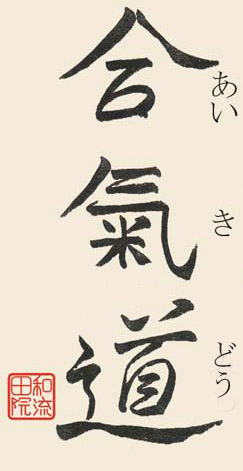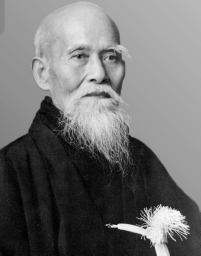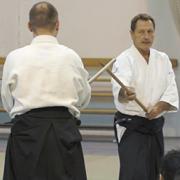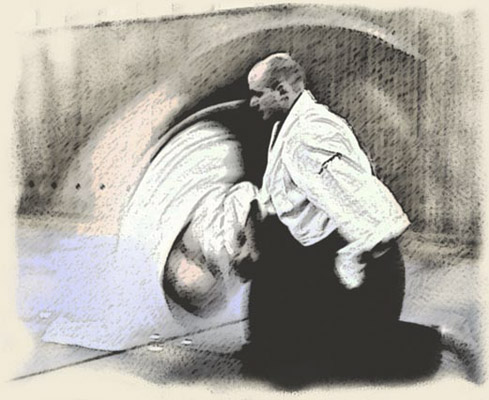What is AIKIDO
|
|
|
Meaning

AI (合), the first character in this reading of the Japanese characters, as a verbkonjugation of "au", means: to reconcile, to harmonize, to be in agreement with so., to comply, to be appropriate, to merge; a very popular mistake is to translate AI in this reading of the Japanese character as "love" - although AI could be translated as love, this AI refers to a totally different character (愛).
KI (気)means: intention, attention, awareness, esprit, soul, disposition - and moreover has an incredible variety of further uses.
AIKI, as a compound noun, is either a technical term of synchronisation or means: synchronous. With regard to Budo, this concept first appeared within some of the sword ryu (school systems) as a technical term. This ryu were further developed into non-armed martial arts and finally resulted in Aikido. On the other hand, based on the multiple meanings of the two components of AIKI, there is a lot of room for interpretation- as usual in Asia. Consequently, based on the Japanese way of thinking, we have three levels of interpretation:
the material: the synchronization with the opposing force.
The human: the human empathy, intuition
The transcendental: as MUSUBI(= knotting together, interrelate) - the founder of Aikido used this concept to emphasize the bond between all beings.
DO (道) is the character for way (also in the broader sense of "way of living"). It has been used in Budo since the Edo period to show the inherent transformation of martial arts from Jitsu, the pure fighting technique, to a much more comprehensive and peaceful concept for living and as art.
back
AIKIDO
Aikido is a Japanese martial art (also refered to as: Budo). Roughly speeking one could regard it as a special variation of Jiujitsu. Aikido is an art involving mainly throws and joint locks, using destabilization of balance rather than pain for controlling the Uke. Aikido is not really suitable as an applicable self-defense technique, because it takes considerable time and effort before Aikido can be used effectively in serious situations.
Aikido was brought to its nowadays appearence after World War II, but nevertheless falls in the category of Kobudo (as e.g. Kenjitsu and other ancient Japanese weapon school systems; ko = old, bu = fight, do = way). This implies, that contrary to Shinbudo (e.g. Judo or Kendo; shin = new) there is no competition, like in sports. Instead of competition Aikido uses the classic Uchitachi-Shitachi principle (student-master principle) and Kata-like procedures for teaching purposes.
The reason for this is either philosophic in nature (e.g. the first priority of the integrity of the partner and of one´s own body), but also caused by technical and cultural aspects: the broad variety of Aikido techniques shall remain unchanged as far as possible. If Aikido were transformed into a sports-system with competition, the necessarily imposed rules of the game (ban or restraints on generally dangerous techniques or entire forms of attacking) would change the techniques significantly to the point of losing its original meaning. A good example for this is the frontal way of attacking an opponent in Judo, as kicks towards the genitals are not included in the rules, they do not need to be considered when taking cover.
Aikido strongly emphazies on the fundamental circumstances and conditions - so called "priciples" of Aikido - that happen to arise in all fighting situations in a broader sense (such as distance, position related to the partner and other spatio-temporal issues) which have to be studied on a physical-intuitive level instead of wracking one´s brains like at school in physics lessons. The main focus is to optimize the combative use of the human biomechanics (maximum rotability of joints, etc.)
Read more about the meaning of Aikido as an Art by Bruno Gonzales: The power of Intention.
back
ORIGIN of AIKIDO
UESHIBA Morihei (1883-1969) Although Aikido has evolved from a sword school, nowadays it is an unarmed Martial Art. The Daitoryu was a sword system that has been passed on by the Takeda family. With Daitoryu-Jujutsu, this system also included a non armed Martial Art section. Especially in the EDO period this tremendously gained in importance, due to the restrictions, imposed by the Shogunate, on armed conflicts between clans, such as expropriation and ordered suicide. To benefit from the sword school and to avoid extensive variations in the techniques of the overall system, the Jujitsu system was based on the same movements as the sword school. Consequently, the way of thinking in Aikido is strongly related to sword techniques, such as cutting an opponent. One of the last men, who mastered this school at the very end of the age of the Samurai was Sokaku Takeda. He was the teacher of the founder of Aikido, Ueshiba Morihei (1883-1969), who further developed the Daitoryu. After WW II and involving extensive spiritualization he renamed the school AIKIDO. Iriminage and Kokyonage were genuinely formed by him.
Although Aikido has evolved from a sword school, nowadays it is an unarmed Martial Art. The Daitoryu was a sword system that has been passed on by the Takeda family. With Daitoryu-Jujutsu, this system also included a non armed Martial Art section. Especially in the EDO period this tremendously gained in importance, due to the restrictions, imposed by the Shogunate, on armed conflicts between clans, such as expropriation and ordered suicide. To benefit from the sword school and to avoid extensive variations in the techniques of the overall system, the Jujitsu system was based on the same movements as the sword school. Consequently, the way of thinking in Aikido is strongly related to sword techniques, such as cutting an opponent. One of the last men, who mastered this school at the very end of the age of the Samurai was Sokaku Takeda. He was the teacher of the founder of Aikido, Ueshiba Morihei (1883-1969), who further developed the Daitoryu. After WW II and involving extensive spiritualization he renamed the school AIKIDO. Iriminage and Kokyonage were genuinely formed by him.
You can find a very detailed histoy of aikido on Dr. Fritz Kemmlers Homepage.
PRINCIPLESOFAIKIDO (ri-nen 理念)
In Aikido certain parameters are defined, which are fundamental and therefore considered to be above the specific technics. Like physics take place in time and space, Aikido-technics have to be within the principles. The most important are (right)attitude (shisei 姿勢), (right) distance (ma-ai 間合) and the focus (me-tsuke 目付け). They have to be conserved during the whole technic. A violation of the principles destroys the whole technic. That is why the greatest attention has to be paid on developing these aspects. Are the obeyed, there is equality between Uke and Tori. Doing the right technic then brings an advantage . Further human principles are added, like the integrity of the body, that means neither harming someone nor risk to be harmed– a unique matter under the martial arts .It resolves from the spiritual roots of Aikido appealing to protect all beeings (banyuuaide 万有愛護).
HANMI (半身)
„Aikido means to move in spiral orbits and to end up in Hanmi" (Osensei UESHIBA)
 Literally translated HANMI means half body, which is the AIKIDO typical way of standing with tilted hips, resulting in a position, where one side of the body is in front; similar to modern boxing stance, one leg half a step ahead. Only, in Aikido, the intention is a different one as in boxing (in boxing, one foot forward stance is used to profit from one’s stronger side):
Literally translated HANMI means half body, which is the AIKIDO typical way of standing with tilted hips, resulting in a position, where one side of the body is in front; similar to modern boxing stance, one leg half a step ahead. Only, in Aikido, the intention is a different one as in boxing (in boxing, one foot forward stance is used to profit from one’s stronger side):Hanmi derived from the Japanese sword schools, where the intention prevailed to minimize the area, that is vulnerable to attack and to limit possible targets to one half of the body. This reduces the reasonable possibilities significantly. Unlike in boxing, HANMI repeatedly changes sides during an Aikido technique. This results in the strong side going weak and the weak side strong (Yin and Yang or jap. IN YO), which is unexpected. Another advantage of using HANMI is, that diagonally done swordcuts (Kesagiri, basis of most movements in AIKIDO) gain a lot of momentum when done in HANMI.
back
IRIMI (入り身)
IRIMI means "into the body", a technical term of spear (Yari) fighting, meaning the penetration of the body. In AIKIDO, the term is used in a more abstract sense: in each AIKIDO technique, there is one essential point, when Tori enters the position of Uke and destroys his position and stability. This is called IRIMI. Mostly it is used to finally destabilize UKE for bringing him down or throwing. Within the stick fighting techniques of AIKIDO (Aikijo), the original meaning is also preserved.
back
UKE and TORI
Uke: the receiving one
Tori: the seizing one
This is the traditional role assignment of Aikido, perfectly corresponding with the principle of Uchitachi-Shitachi. Uke takes the role of the attacker. Tori exercises the actual Aikido technique. Both are equally important to make progress in Aikido and depend on each other to make progress and to gain understanding. Normally, Uke and Tori change roles after performing 4 techniques.
Uke:
In Japan they don´t discuss the tasks of Uke extensively. The way to study the role of Uke in Japan is thus, being used for demonstration during classes by the sensei. If one doesn´t meet the standards of sensei, one will not be used any more as an uke until a change for the better can be seen. The role of the Uke is of utmost importance for establishing a profound understanding of Aikido. Uke needs a deep understanding of all principles of Aikido such as: MAAI (distance), SHISEI (posture) and RIAI (logic within the technique), as well as for the correct attack (gripping and beating techniques) and the right way of moving the body by handling the application of an Aikido technique (Ukemi). Uke has to present the ideal conditions to Tori for comprehending the technique without anticipating it - or even worse, frustrating it. You should train with as many Uke as possible, to get a good understanding. Osensei said 万人と稽古をすれば、名人になれる - Practise with tenthousand people and you can become a master.
Tori:
Tori is the one who executes the actual Aikido-technique. He is responsible for the safety of uke. Like uke he tries to understand and apply the principles of Aikio.
back
KIHON and APPLIKATION
While training we distingush between basis-technik (Kihon 基本) and applikation (Ouyou 応用).
The basis-technik is standardised and should work under all conditions. This form is to be shown while making examens. Because it is set up of many diffrent "steps", it takes quite a time even if done the fastes way possible.
Therefore the application (Ouyou 応用) is made. Here components if the Kohon are left out or are even changed. This is why it speeds up, but makes it onyly possible to be applied in the certain case it has been developed for (e.g. attack, speed, e.c.t.).
Bernhard Wardein

